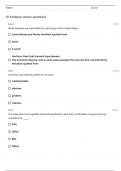Name: Score:
111 Multiple choice questions
Term 1 of 111
What diseases are transmitted by bed bugs in the United States
Lyme disease and Rocky Mountain spotted fever
None
C and E
Northern Deer ticks transmit lyme disease
The American dog tick, and in some areas possibly the lone star tick, transmit Rocky
Mountain spotted fever
Term 2 of 111
Silverfish and firebrats prefer to consume
carbohydrates
starches
proteins
vitamins
Term 3 of 111
The state plan that regulates pesticide applicators and their certification is approved and
evaluated by ________.
FDA
USDA
EPA
OSHA
,Term 4 of 111
The best control method for bats in attics is apply naphthalene crystals
True
False
Term 5 of 111
Cockroaches need _________ to be successful.
food, moisture, harborage
food, moisture, open spaces
warmth, food, cracks,
cracks, crevices, food
,Term 6 of 111
Describe the pest management procedures for a stinging insect problem where stings and
specimens were the only clues provided by the client.
1. Aerial Yellowjackets: locate aerial nest. Using a bee suit, apply canned pressurized
pesticide to the entrance at the time of day when most wasps are in the nest. Cut the nest
out of the shrub etc and discard it when occupants are dead
2. Ground nesting Yellowjackets: Locate nest entrance in ground. Using a bee suit, at the
most appropriate time of day spray or dust pesticide in entrance hole. Dust a plug of steel
wool, etc and insert it into the entrance.
3. Yellowjacket in wall void: Locate the nest entrance in the structure. Using a bee suit
approach the entrance in the safest manner, inject spray from a canned pressurized
pesticide and plug the entrance with pesticide dusted steel wool. Caulk up entrance after
assurances that the nest is no longer active.
4. Honeybee in wall void: Locate the colony entrance. Inspect inside the structure as well as
outside, Using a bee suit, inject spray in the entrance using a canned pressurized pesticide
and plug the hole with pesticide dusted steel wool. As soon as it can be ascertained that
honeybees are no longer alive, remove comb, dead bees, honey, etc. Do not let the comb
and honey supply melt and run.
The female black widow spider has a shiny jet black body and legs. Her globose abdomen
is proportionally large with a red hour glass design on the belly. This design can be easily
seen and taken as a warning since the black widow hangs upside down in her cobweb. Male
black widows are small striped and harmless
Inspect accumulations of logs, wood, bricks, construction materials, as well as stacks of
baskets and equipment that has not been moved for some time. Privies, sheds, and inside
such things as water meters are potential nesting places. Black widows move into secluded
spaces and remain if they are not disturbed. Be careful when reaching into potential black
widow nesting places.
The brown recluse spider, loxosceles reclusa, has a brown cephalothorax with a dark violin
shaped design on the dorsal surface. The abdomen is a tan brown color with no distinctive
markings. The brown recluse is found in houses within an arched shaped geographical
range encompassing states in the south and midwest bordered by Texas, Oklahoma,
Kansas, Missouri, Iowa, Illinois, Kentucky, Tennessee, and Alabama. Several other species of
closely related recluse spiders are found in the southwestern deserts and one is regularly
introduced from the mediterranean area. None of these latter species is considered
particularly harmful.
, Definition 7 of 111
Seek out infested materials that are producing yeast; over ripe fruit and vegetables, open or
broken cans of fruit and vegetables, sour mops and rags, moist pet food and bedding. Use traps
baited with ripe banana to locate the main infested area. Eliminate yeast producing materials.
Name and discuss pest management procedures used to suppress late summer invading
populations of black and red bugs
Describe inspection procedures for the brown recluse spider
Describe inspection procedures for black widow spiders
List at least three pest management procedures for fruit fly or Drosophilia infestations
Term 8 of 111
Which of the following is not true about adult rat droppings
They average 5/16 inch long
Fresh droppings are black or nearly black
The highest number of droppings will be found where rats rest or feed
A single rat can produce 50 droppings in a day
Term 9 of 111
Describe the life cycle of the cluster fly.
One group of flies is mosquito or gnat-like with obvious, even somewhat long antennae.
Their larvae have a head capsule and usually live in water. The rest of the flies, the majority
of the species, are usually not mosquito-like but are more robust with very small antennae.
The larvae of this group are often maggot-like.
Cluster fly larvae parasitize earthworms. In the late warm moths of summer, especially
August, they often enter buildings where they overwinter. On warm winter days these flies
and others, make nuisances of themselves by flying around. Cluster flies along with house
flies, face flies, and flesh flies are part of the "attic fly" fauna.
B
A





